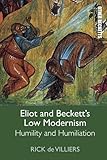Eliot and Beckett’s Low Modernism : Humility and Humiliation / Rick de Villiers.
Material type: TextSeries: Other Becketts : OTBEPublisher: Edinburgh : Edinburgh University Press, [2022]Copyright date: ©2021Description: 1 online resource (264 p.)Content type:
TextSeries: Other Becketts : OTBEPublisher: Edinburgh : Edinburgh University Press, [2022]Copyright date: ©2021Description: 1 online resource (264 p.)Content type: - 9781474479035
- 9781474479059
- 821/.912 23
- PS3509.L43 D48 2021eb
- online - DeGruyter
| Item type | Current library | Call number | URL | Status | Notes | Barcode | |
|---|---|---|---|---|---|---|---|
 eBook
eBook
|
Biblioteca "Angelicum" Pont. Univ. S.Tommaso d'Aquino Nuvola online | online - DeGruyter (Browse shelf(Opens below)) | Online access | Not for loan (Accesso limitato) | Accesso per gli utenti autorizzati / Access for authorized users | (dgr)9781474479059 |
Frontmatter -- Contents -- Series Editor’s Preface -- Acknowledgements -- Abbreviations and Conventions -- Introduction -- 1 Fat Fingers and Private Truths: Between Manners and Morals in Eeldrop and Appleplex -- 2 Pudenda of the Psyche: Embarrassment in More Pricks than Kicks -- 3 Mr Eliot’s Sermons and Sermonising: Participation, Good Will and Humility in Murder in the Cathedral -- 4 A Defence of Wretchedness: Molloy and Humiliation -- 5 Assuming the Double Part: Irony as Humility in East Coker -- 6 How It Is and the Syntax of Penury -- Conclusion: Humility’s Edges -- Bibliography -- Index
restricted access online access with authorization star
http://purl.org/coar/access_right/c_16ec
Explores the relation between humility and humiliation in the works of T. S. Eliot and Samuel BeckettOffers the first book-length comparative study of T. S. Eliot and Samuel BeckettDevelops a literary theory of humility and humiliation – concepts whose definitions have largely been determined by philosophy and theologyExplores the relation between negative affect, ethics and aestheticsHumility and humiliation have an awkward, often unacknowledged intimacy. Humility may be a queenly, cardinal or monkish virtue, while humiliation points to an affective state at the extreme end of shame. Yet a shared etymology links the words to lowliness and, further down, to the earth. As this study suggests, like the terms in question, T. S. Eliot and Samuel Beckett share an imperfect likeness. Between them is a common interest in states of abjection, shame and suffering – and possible responses to such states. Tracing the relation between negative affect, ethics, and aesthetics, Eliot and Beckett’s Low Modernism demonstrates how these two major modernists recuperate the affinity between humility and humiliation – concepts whose definitions have largely been determined by philosophy and theology.
Mode of access: Internet via World Wide Web.
In English.
Description based on online resource; title from PDF title page (publisher's Web site, viewed 25. Jun 2024)


